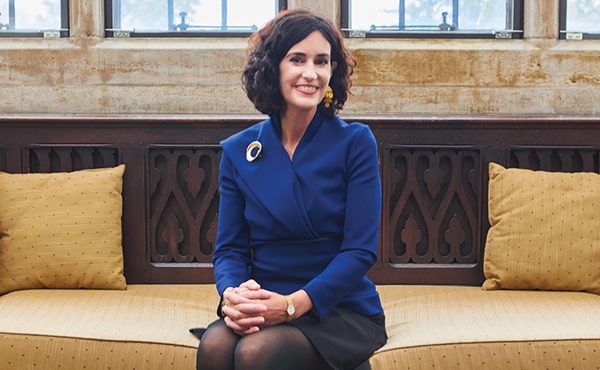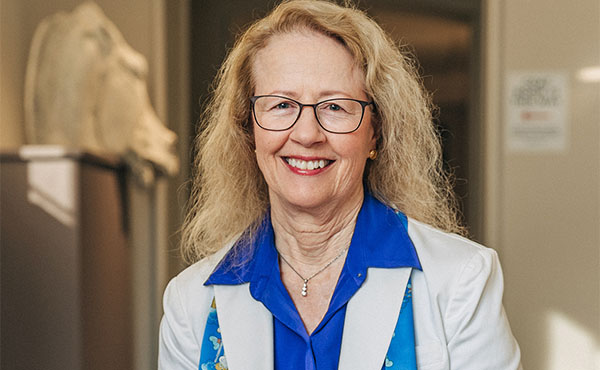Dr. Emily Orlando’s study of American novelist Edith Wharton also illuminates our own era.
The English major demographic has significantly changed since I was an undergraduate. Today my students are overwhelmingly women. And these women — they love Wharton. They love her because she understands power, gender, money, sex, and fashion... And she understands mean-girl behavior.
— Emily Orlando, PhD, English Professor
Once viewed by some in the 20th century as a sort of well-heeled literary sidekick to more bold-faced contemporaries, how is it that perspectives on the American Gilded Age writer Edith Wharton (1862-1937), author of novels such as The House of Mirth and The Age of Innocence, have shifted to the point that her work now launches discussions about the character of our lives today?
That’s the focus of the scholarship of Emily Orlando, PhD, the E. Gerald Corrigan Chair in the Humanities and Social Sciences at Fairfield University and a professor in the English Department, as she affirmed in an interview with Fairfield University Magazine.
One hundred years ago, Wharton predicted that “the future belonged to the showy and the promiscuous,” which appears to have been prophetic. In addition to that type of mordant observation, of which Wharton’s work is filled, her writing offers a vantage point from which to view many relevant 21st century tensions.
Wharton’s literary contributions serve as a link between periods and regions. Born in New York City during the Civil War, she lived through World War One. Bridging the gap between European and American culture, she made her home in France for decades, steeped in the transatlantic literary scene. A friend and contemporary of Henry James, she wrote poetry, memoirs, plays, murder mysteries, ghost stories, and much more.
Most famous for novels that chronicle life in late 19th century New York, Wharton is a useful lens for looking at the complexities of our own era, because her writing explored how affluent lives were nonetheless constrained by tradition, family, marriage, social expectations, and – for women in particular – limited access to financial independence.
“The English major demographic has significantly changed since I was an undergraduate. Today my students are overwhelmingly women,” said Dr. Orlando of her students. “And these women — they love Wharton. They love her because she understands power, gender, money, sex, and fashion. Wharton famously suggested that ‘genius is of small use to a woman who does not know how to do her hair.’ She gets that women are often assessed by their looks. And she understands mean-girl behavior.”
Another part of her appeal to students today is that Wharton chronicled what it meant to be a woman in New York, and what it took to survive. Some of Wharton’s iconic female characters — like Undine Spragg in The Custom of the Country (1913), or May Welland in The Age of Innocence (1920) — are depicted as coldly calculating, grasping and manipulative.
Spragg is shown as a ruthless seeker of money and status, without any real sense of history or meaningful style. She’s a neglectful mother and a petulant spouse. Welland is quietly deceitful in her efforts to secure her marriage. But their machinations are presented as the manifestations of a culture that requires much be unspoken or concealed.
Wharton views group behavior with a clinical eye, often deploying anthropological concepts to cast the rituals, taboos, and customs of Gilded Age aristocracy as something remote, possibly primitive, and governed by its own set of codes that are inscrutable to outsiders. “She’s looking at Old New York as a tribe, and at the tribal warfare those groups engaged in,” Dr. Orlando said.
In the words of the narrator of The Age of Innocence, “In reality they all lived in a kind of hieroglyphic world, where the real thing was never said or done or even thought, but only represented by a set of arbitrary signs.”

Edith Wharton’s writing desk at The Mount in Lenox, Massachusetts, which was the writer’s home in the early 1900s.
Wharton also wrote about visual culture, interior design, fashion, and gardening. Her first big book was The Decoration of Houses in 1897, a work that championed a more decluttered and stripped-down approach. “It’s all about streamlining,” said Dr. Orlando, who edited the first annotated edition of The Decoration of Houses, due out in October of this year from Syracuse University Press. “It’s very opposed to Victorian decor.”
“[H]er writings across the genres provide the tools to critically examine the vicissitudes of our complicated, fractured world as we advance into the third decade of the new century,” wrote Dr. Orlando in the introduction to The Bloomsbury Handbook to Edith Wharton, a 2023 anthology of recent Wharton scholarship that she edited.
Dr. Orlando is the author of Edith Wharton and the Visual Arts, published in 2007 by University of Alabama Press, a book that investigates Wharton’s treatment of the ways that women are represented in art through the lens of male-centric ideas and fantasies.
Wharton’s interest in the ways that women are seen might be one of the reasons her work is being embraced by TV and film directors. Her 1905 novel The House of Mirth was turned into a film in 2000. Writers on shows like Sex & the City and Gossip Girl have tipped their hats to Wharton. Her unfinished novel The Buccaneers, published posthumously in 1938, was turned into a TV series in 2023. Martin Scorsese’s critically acclaimed 1993 film adaptation of The Age of Innocence, and the film version of Wharton’s 1911 book Ethan Frome released the same year, spurred moviegoers to discover Wharton’s books.
Literary fame — like every other kind of fame — can be fickle. Herman Melville was largely disregarded for 30 years or so after his death. Emily Dickinson was essentially unknown during her lifetime. But the case of Edith Wharton follows a different course. She was famous during her lifetime, the first woman to be awarded the Pulitzer Prize (in 1921 for The Age of Innocence). She was independently wealthy, but she made more money from her writing than she did from her inheritance.
Wharton’s reputation continues to climb because she seems “to have foreseen the excesses, obsessions, and spectacles of our current climate,” Dr. Orlando wrote in her introduction to the Bloomsbury Handbook.
The ways that the preening narcissism of our New Gilded Age echo and rhyme with Wharton’s depictions of hers explain why Wharton’s work is back in style. In a book like The Custom of the Country from 1913, the sketchy real-estate deals, crude art-market speculation, and the bombastic swagger of the powerful all seem very much of our 21st century moment.
“I’ve been writing on her since the ’90s, and she’s never been hotter,” said Dr. Orlando of Wharton’s ever-growing grip on modern readers. “Students want to read her.”
Wharton, toward the end of her life, was aware that the literary Modernism in the 1920s and ’30s made her already backward-glancing novels appear out of date to some, but she suspected rightly that those who discounted her insights into human nature might have been misled by period details or surface distractions.
Another possible factor that has made Wharton a difficult sell for some readers over time has been the grimness of vision, particularly the way she ties her novels together with unhappy endings. “Not everybody has the palate for Wharton’s endings, because they’re brutal,” said Dr. Orlando.
Sympathetic characters are cast aside or driven to suicide, like Undine’s son Paul, and his father Ralph Marvel, respectively, in The Custom of the Country. Or, as in Ethan Frome, where the quest for forbidden love of the two main characters results in misery and disfigurement. These are no feel-good stories, but perhaps 21st century readers have developed more of a taste for things with bitter and sour notes.
“I will never tire of her, and that’s the key. She’s the gift that keeps giving,” Dr. Orlando averred.
Indeed, because of Wharton’s unique life, her adjacencies and her still under-explored body of work, Wharton’s writing can be instructive in a variety of academic contexts, such as classes in the American novel, women writers, Edwardian and Victorian fiction, the Pre-Raphaelite Movement, the Harlem Renaissance (in relationship to Nella Larson’s novels in particular), literature and design, travel writing, and more.
“I try to sneak her into every single class I teach,” said Dr. Orlando, “and I succeed.”








